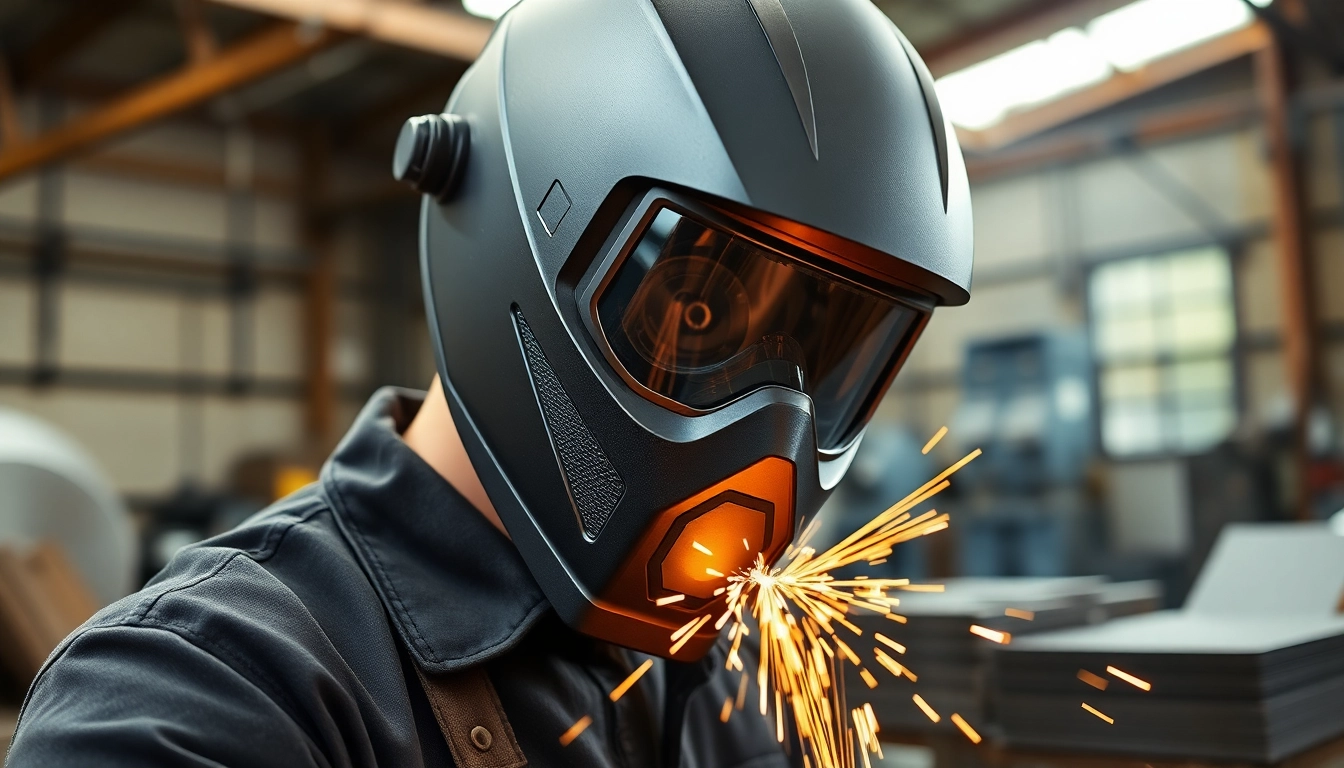
Understanding the Importance of a Welding Mask
Welding is a critical skill that requires not only technical knowledge and proper techniques but also adequate safety measures. Among these safety measures, a welding mask is indispensable for protecting a welder against various hazards encountered during the welding process. The right welding mask offers protection from harmful light, sparks, and fumes generated during welding operations, making it essential for anyone working with high-temperature materials and equipment.
What is a Welding Mask?
A welding mask, often referred to as a welding helmet, is a personal protective equipment (PPE) designed to shield a welder’s face, eyes, and neck from damaging electromagnetic radiation and heat produced during the welding process. Modern welding masks feature advanced technologies, such as auto-darkening filters, which automatically adjust the lens’ shade to provide optimal visibility while protecting against bright flashes. These masks are integral not only to a welder’s safety but also to their overall productivity, as they allow for clearer visibility while monitoring the welding process.
Key Features to Look for in a Welding Mask
Choosing the right welding mask involves understanding its features and how they contribute to user safety and comfort. Here are some essential features to consider:
- Auto-Darkening Filter: This feature darkens the lens automatically during the welding process, allowing for better visibility before and after the arc is struck.
- Lens Shade Range: Different welding processes require varying shade levels. Look for masks with a variety of shade options, typically rated from 8 to 13.
- Comfort and Fit: A comfortable mask with adjustable headgear is crucial for prolonged use. A good fit ensures no gaps, which could expose the welder to harmful radiation.
- Weight: Lightweight designs reduce neck strain and improve overall comfort, making it easier to work for extended periods.
- Respiratory Protection: Some masks come with built-in respirators to protect against toxic fumes and gases.
Common Safety Standards and Certifications
Welding masks must comply with specific safety standards to ensure they provide adequate protection. In the United States, the American National Standards Institute (ANSI) and the Occupational Safety and Health Administration (OSHA) set regulations for personal protective equipment. Look for masks that meet the following standards:
- ANSI Z87.1: This standard specifies the requirements for eye and face protection devices used in occupational environments.
- ISO 4871: This standard involves safety and performance specifications for welding helmets.
- CSA Z94.3: This is a Canadian standard governing personal protective eyewear and specifies the requirements for the design and use of welding helmets.
Types of Welding Masks Available
Welding masks come in various types, each designed for different applications and techniques. Understanding the available types allows welders to choose the best mask for their specific needs.
Auto-Darkening vs Passive Welding Masks
One of the primary distinctions in welding masks is between auto-darkening and passive masks. Auto-darkening masks contain sensors that detect the brightness of the welding arc. When the arc is struck, the lens instantly darkens, allowing for clear visibility during welding without the need for the welder to raise or lower the mask. Conditions under which automatic darkening masks excel include:
- Improved Visibility: Welders can see the workpiece more clearly before and after striking the arc.
- Comfort: Eliminates the need to lift the mask frequently, leading to a more comfortable working experience.
Conversely, passive masks utilize a fixed shade lens and do not adjust automatically. These are typically less expensive but may not offer the same level of comfort or visibility as auto-darkening options. Welders should consider their skill level and preferred working conditions when choosing between the two.
Specialized Welding Masks for Different Techniques
Different welding techniques may require specialized masks tailored to specific tasks. For instance:
- MIG and TIG Welding: For these techniques, welders may use masks with lighter lens shades for enhanced clarity.
- Arc Welding: This generally requires a darker lens to protect against the intense light and heat.
- Plasma Cutting: Masks designed for plasma cutting may include features such as a larger viewing area to improve visibility during intricate cuts.
Material and Comfort Considerations
The materials used in the construction of welding masks will impact their durability, weight, and user comfort. Masks can be constructed from various materials, including:
- Plastic: Lightweight and affordable, making them suitable for novice welders.
- Fiberglass: More robust and heat-resistant, ideal for industrial environments and heavy-duty use.
- Metal: Often seen in more specialized applications or with heavy-duty designs; while durable, these may be heavier.
- Comfort Padding: Many masks come with padding to minimize discomfort during prolonged use.
Choosing the Right Welding Mask for Your Needs
Selecting the right welding mask is crucial for safety and efficiency. Familiarizing oneself with different options and considering personal requirements will lead to an informed purchasing decision.
Assessing Your Welding Method
Different welding methods come with varied requirements. Assessing your work type will dictate the appropriate mask to choose. If you conduct work in various environments, an adjustable or versatile mask that accommodates multiple settings may be beneficial. For example, if you frequently engage in TIG welding, opting for a mask with excellent visibility and a lighter shade will enhance your overall experience.
Budgeting for Quality: Price Ranges Explained
Welding masks vary significantly in price, typically reflecting the quality of materials, features, and brand reputation. Here’s a breakdown:
- Entry-Level Masks: Start around $30 to $80. These are often basic and suitable for occasional users or hobbyists.
- Mid-Range Masks: Range from $80 to $200, these often include auto-darkening features and additional comfort features.
- Professional and Specialty Masks: Can cost $200 and up. These masks are robust, offer the best protection, and feature cutting-edge technology.
Investing in a high-quality welding mask is crucial to ensure long-term safety and effectiveness, especially for professional welders.
Where to Buy: Top Retailers and Online Stores
When it comes to purchasing a welding mask, multiple options are available, both online and in physical stores. Here are a few reliable sources:
- Home Improvement Stores: Established chains such as The Home Depot and Lowe’s carry a variety of welding masks closely tailored to the domestic work environment.
- Specialty Welding Suppliers: Websites like Cyberweld and Baker’s Gas provide an extensive selection and detailed product descriptions.
- Amazon: Often features an extensive range with customer reviews, giving insights into real-world usage.
Maintenance and Care for Your Welding Mask
Proper maintenance of your welding mask enhances its lifespan and ensures ongoing protection. Here are best practices for clean use and storage:
Regular Cleaning Practices
Since welding masks deal with both light and heat, they can accumulate soot, dust, and grime over time. Regular cleaning is essential. Here are steps to clean your mask:
- Use a soft cloth to wipe the exterior after each use.
- To clean the lens, use a gentle lens cleaner safe for auto-darkening lenses. Avoid abrasive materials that can scratch or damage the filter.
- Check and replace any damaged lenses or filters as necessary.
Storage and Protection Tips
Protecting your welding mask when not in use is as important as cleaning. Proper storage minimizes damage. Here are some suggestions:
- Store your mask in a protective case or pouch to avoid scratches and accidental damage.
- Keep it in a cool, dry place, away from direct sunlight and extreme temperatures.
- Avoid placing heavy items on top of your welding mask, which could cause it to become deformed or damaged.
When to Replace Your Welding Mask
Even with careful use and maintenance, welding masks will eventually require replacement. Signs that it’s time to get a new mask include:
- Severe scratches or damage to the lens affecting visibility.
- Malfunctioning auto-darkening features or sensors.
- Cracks or excessive wear on the mask material.
- Discomfort when wearing due to loss of padding or structural integrity.
Frequently Asked Questions About Welding Masks
As welding masks are crucial to ensuring safety, many questions arise regarding their use. Below are some common queries:
What Welding Masks Are Best for Beginners?
For beginners, choosing a welding mask that balances comfort, visual clarity, and affordability is essential. Basic auto-darkening masks can range from $80 to $150, providing a user-friendly experience while protecting effectively during welding. Brands like Lincoln Electric or Miller offer reliable entry-level solutions.
Can a Welding Mask Protect Against Other Hazards?
While welding masks are primarily designed to guard against welding-related hazards, they can also provide some level of protection against minor impacts and flying debris. However, they are not designed to offer comprehensive protection against chemical fumes, which may require additional respiratory protection equipment.
Understanding the Lifespan of Your Welding Mask
The lifespan of a welding mask can vary based on the frequency of use and the care taken during storage and maintenance. Typically, a high-quality mask may last for years if maintained correctly. However, it is advisable to inspect the mask regularly and replace it when any of the protective features degrade significantly.






